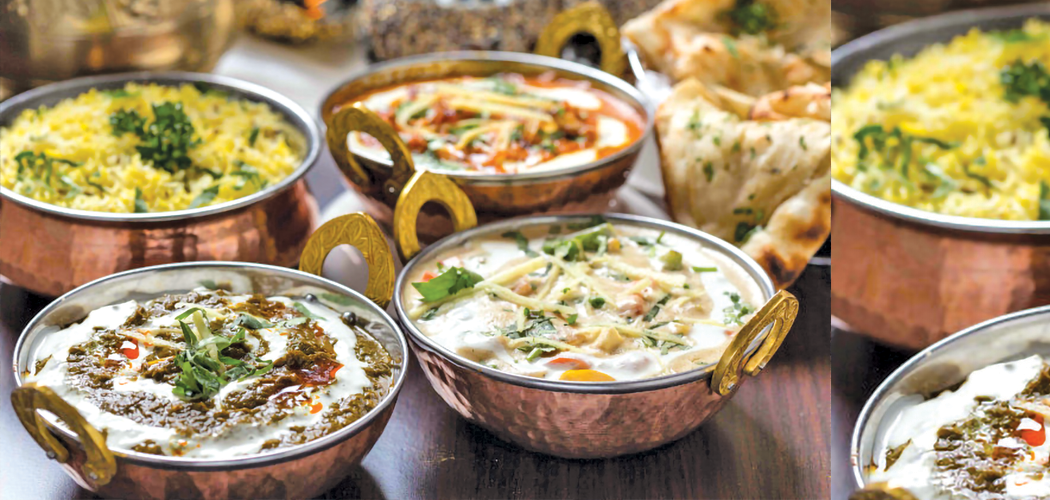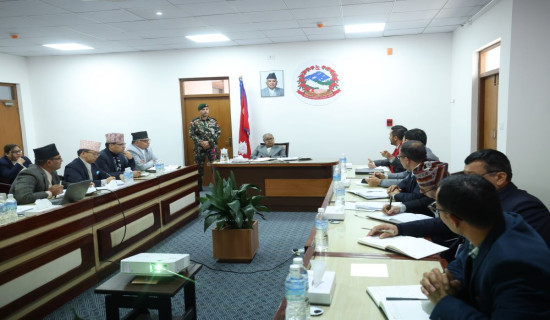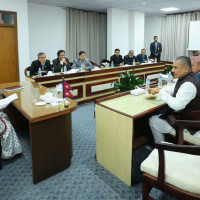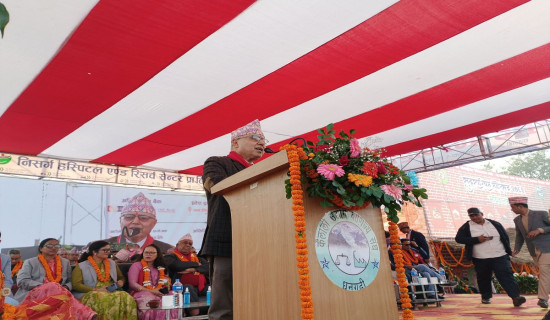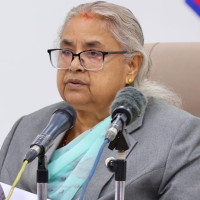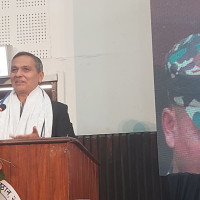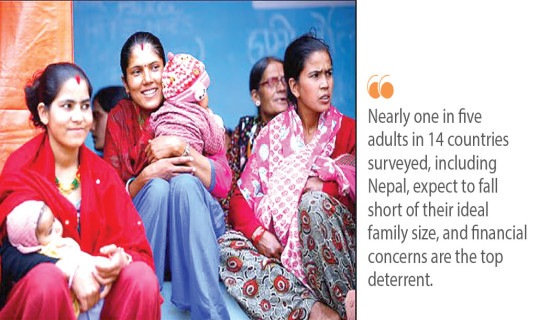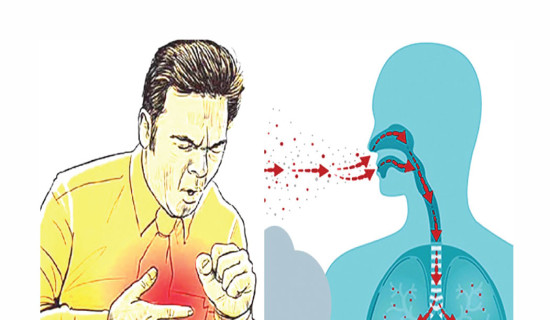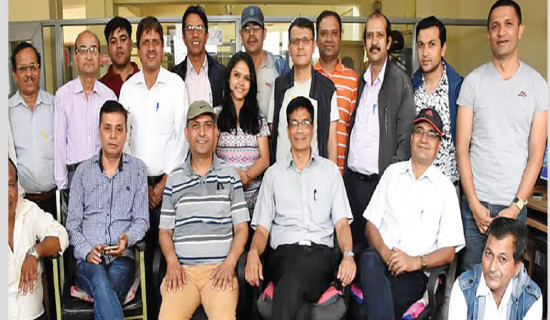- Tuesday, 9 December 2025
Sacred Teej mores turn showy, sullied
Kathmandu, Aug. 28: Teej is right here. Many women in Kathmandu Valley and other urban areas are busy feasting in one venue after another. Believe it or not, a woman enjoys 10-20 Teej feasts in a fortnight. Sabina Barakoti was one of those attending 12 Teej feasts within two weeks and she felt that Teej programme was a means of socialisation, like meeting friends, colleagues, relatives, and sharing happiness and sorrow. “It is a part of our culture,” she said.
With rising Teej feasts, news stories have also come that woman felt ill after feasting. Ambika Dhungel of Bhaktapur was one of those getting ill after attending two Dar parties in a single day. She suffered food poisoning.
Sabita Shah, a lecturer at Global College of Management, has a different view. She had always skipped Dar programme when she was invited at party venues or restaurants. “For me, partying at a party palace and restaurant never gives the essence of Teej feast. I would attend if somebody welcomed at home with homemade foods.”
The general idea of Dar nowadays has turned out to stuff oneself with varieties of foods including deep fried, junk food items and fast food, which is not good for health, said Shah.
Health experts have warned that excessive eating and frequent feasting makes one ill as they cannot digest the food.
Changing trends of Dar
Is it good to have so many parties? Yes, feasts may help deepen social relations, but one must be cautious as it may invite health problems. Talk to any women aged over 70 and they will tell you that Dar feast used to be limited for just one day, on the eve of the Teej fasting.
Teej celebration was limited within our maternal home, ‘Maiti’, there used to be more excitement for meeting parents, childhood friends and sisters. But now, Teej celebration has not its limitation, it has become a platform for politicians, clubs, women’s groups, cooperatives, organizations, offices and what not, said Rama Wagle, 73, a retired teacher.
The traditional Dar had several delicacies from Nepal called Dhakani, rice cooked in ghee and milk, rice pudding, sel roti, sweets and yoghurt, seasonal vegetables and pickles. Dar in its true essence was meant something delicious that was not the part of regular meal.
Dar is supposed to comfort women and sail her through 24 long hours of fasting on Teej day.
But these days, it is not surprising that one will find continental foods and even wine in Dar programme and Teej party, said Wagle.
Professor Dr. Beena Poudyal, retired head of Tribhuvan University’s Central Department of Nepalese History, Culture and Archaeology, thinks women’s access to education, socialization and involvement in various organisations has led Teej celebration to an expanded form.
“We must preserve the cultural values of Teej by celebrating it in a decent way,” said Poudyal.
It is not bad to gather, sing and dance, but it will be offensive if it turns out to be unacceptable by the society and adds financial burden.
For many rural women at present, Teej marks an end of field work, when exhausted by workload daughters-in-law could finally find a way to visit their Maiti, eat delicious food made by their mothers and grandmothers, sing, and dance and share their happiness and sorrow with their kins, said Poudyal.
Changes in culture
Teej festival is dedicated to the Goddess Parvati, marking her day of union with Lord Shiva. It is observed for the wellbeing of husband, children, families and purification of body and mind.
The ritual value of Teej is changing year after year. The values are being replaced by modernization process that is assumed as the demand of changing times, said Poudyal.
Women’s exposure to various sectors including education, profession, improved economic condition, impact of different social media is responsible for changing the value systems, she added.
Globalisation has also become responsible for the creation of fusion cuisine or music and fashion. The impact of globalisation on Teej-related activities can be observed on various fronts including songs, music, dance, dresses, ornaments, foods, and drinks. Nisha Kafle, a college student, said she does not like to observe fasting but loves wearing Teej attires and enjoy foods of Dar.
Fasting or non-fasting, all women take part in the recreation and fun of Teej such as dancing, eating, dressing, make up, gathering and, most importantly, visiting shrines of Lord Shiva. Women have shortened the ritual of worshipping and fasting and widened the trend of gathering and recreational activities.
Challenging commodified trends
Teej festival is now celebrated beginning one to two months before the main festival. It has now become a trend to organise Teej programme in posh restaurants and banquets spending a lot of money, said Shanta Aryal, 65, a social worker.
Attending Teej programme means you are attending a grand party where alcoholic beverages and non-vegetarian delicacies are part of the platter which is very different from what it used to be. Teej programme has become a competition about who can spend more money, wear the expensive dresses, jewelry and other accessories, she added.
“I do not understand where our society is heading in the name of modernization,” she expressed her concern.
Teej songs now incorporate fancy raps and lyrics that have nothing to do with tradition or festivities. Seriously, Teej festival has turned out to be an occasion for commercialization in terms of dress patterns, food habits, cosmetics, and accessories.
Tara Dhakal, a journalist, is not happy with the rising fashion trends during Teej as many have forgotten to enjoy the originality of the festival.
The nature of Teej songs and attires has altered over the years, said culture expert Poudyal. Teej songs always are a genre in a form of expressing ‘her story’ where women tell their stories but now they have become commodified.
Instead of knowing the true essence of Teej songs, artists are being driven by capitalist motives, to cash in on a song’s popularity and getting viral through social media including Facebook, TikTok and YouTube.
Ensure healthy fasting
Dar, a pre-fasting feast on the eve of Teej festival, should comprise protein and carbohydrate-rich food, which when consumed in ample amount would fill the stomach until the following day.
Intake of junk food and alcohol dehydrates the body and increases the cravings on the day of fasting, said Prof. Dr. Jaya Pradhan, a nutritionist.
People love delicious Dar but most of us end up eating it the wrong way, which gives rise to thirst and dizziness on the day of fasting, she warned.
Fasting is an integral part of Teej. Many Nepali Hindu married women observe Teej fasting, praying for the longevity and good health of their husbands and family members. However, 24 hours of arduous fasting may have positive impacts as well as health hazards, informed Dr. Pradhan.
Women should know their body before fasting and do accordingly. People should eat and drink fruits, water and milk if they feel uncomfortable.
Various studies have shown that general fasting for 16 hours boosts the human growth hormone produced by the pituitary gland. This will eventually help for better metabolism and overall, it helps with the recovery of the body.
Talking about the benefits of fasting, Dr. Pradhan said that the body cleans out old, damaged cells and regenerates newer and healthier cells while fasting. Also, you are cleansing toxins from the body and giving a break to the digestive system.
Dr. Pradhan suggests avoiding alcohol, non-veg items, junk, and fast foods in the eve of Teej festival if you are fasting.
According to Dr. Pradhan, people including pregnant women, breastfeeding women, diabetics, people with low blood pressure, people under medication, people with eating disorders, people with fluctuating blood sugar levels and people with severe gastritis should avoid fasting.

